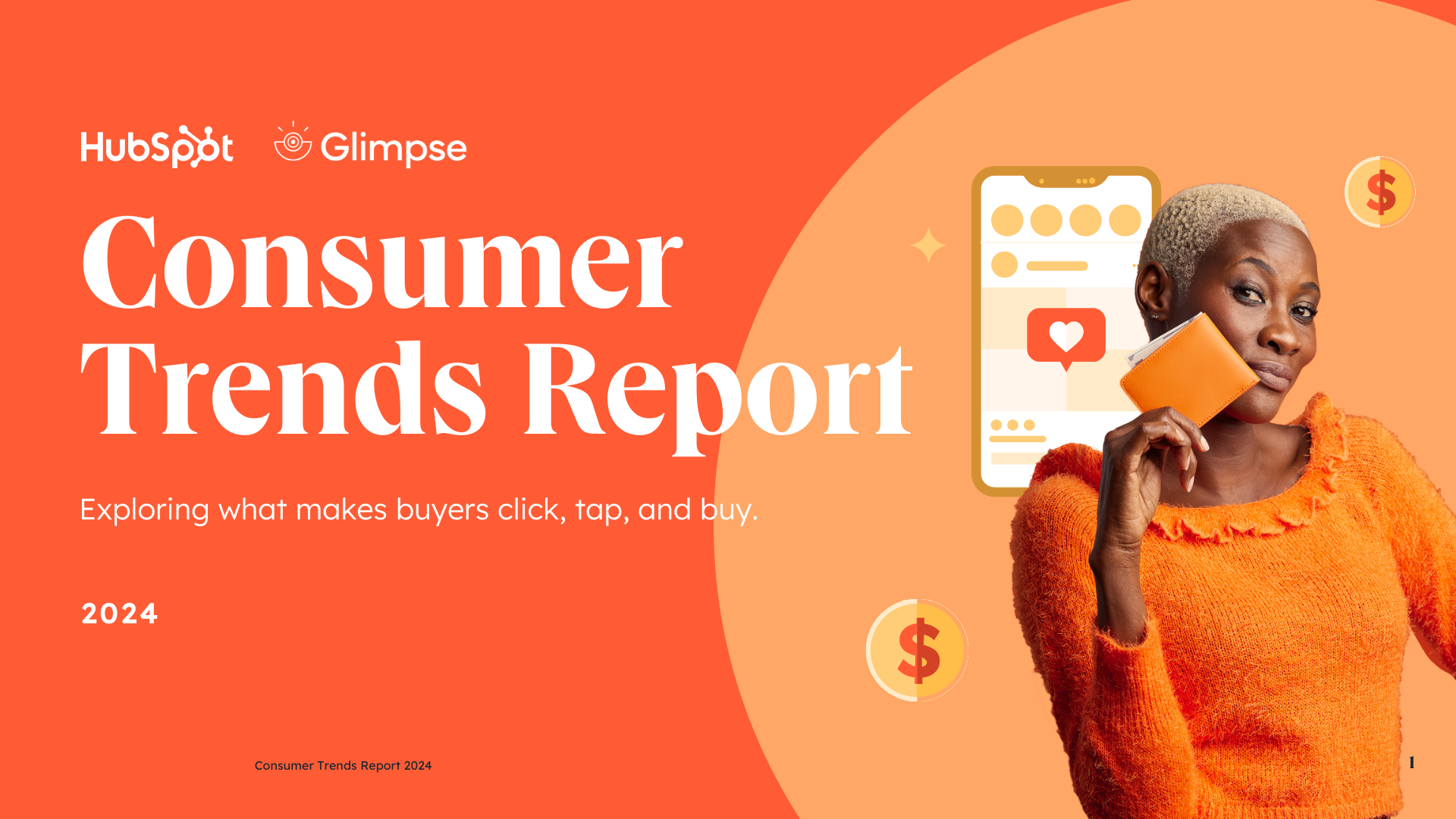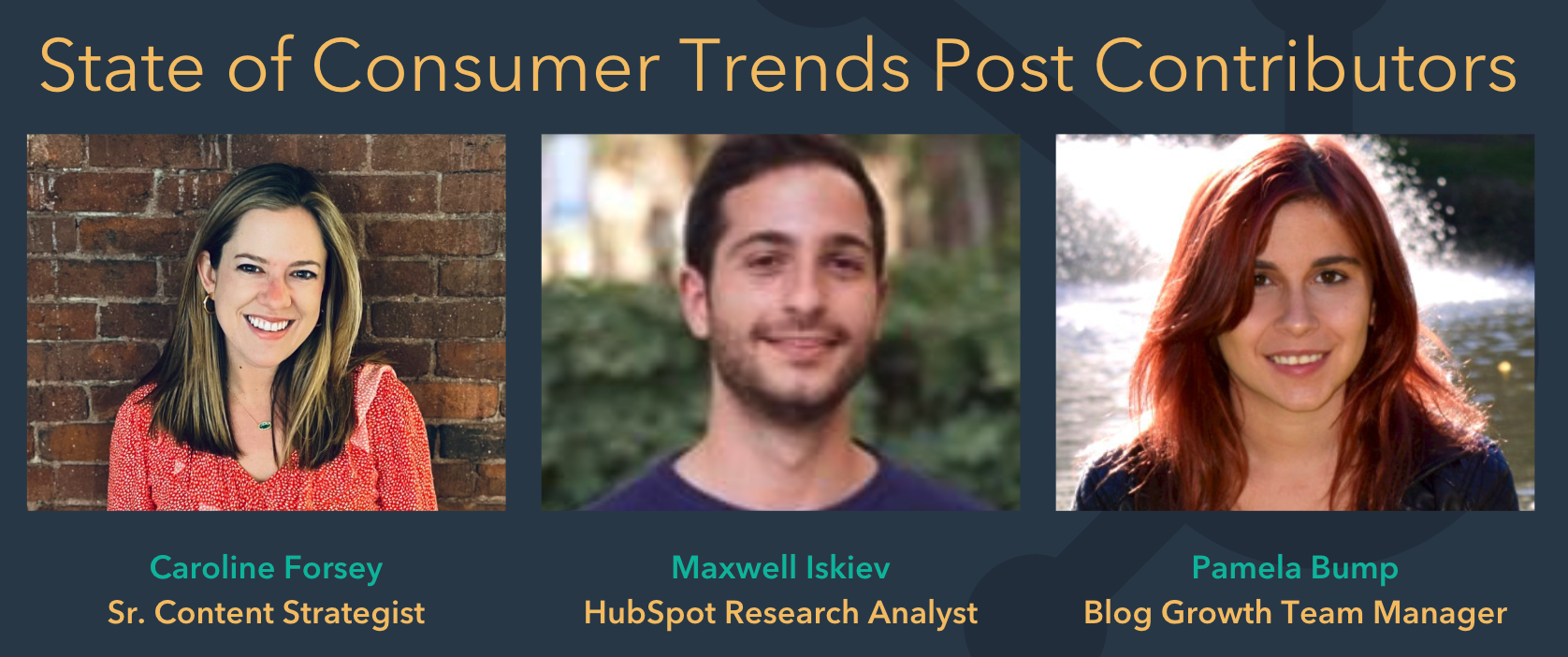Consumer trends are changing all the time, reflecting the “never-sleeping” nature of markets and society.
From the rise of AI to the growing popularity of shopping on social media, heightened data privacy concerns and consumers tightening budgets due to recession fears, times are changing fast.
But one thing is certain — businesses need to track all these trends to avoid getting lost in the shuffle.
To help marketers keep up and stay ahead of the curve, we’ve run our biannual Consumer Trends Survey of 700+ U.S. adults. Keep a pulse on:
- What trends they’re following.
- How they spend their time online.
- How and where they prefer to shop.
- What standards they’re holding their favorite brands to.

U.S. Consumer Trends Report
Learn how consumers act, how they think, and what they expect now and beyond. Topics include:
- Purchase habits.
- Data privacy.
- Workplace trends.
- And more!
Download Free
All fields are required.

Chapters
Top Consumer Trends
Before jumping into all the trends, let’s highlight those that stand out in 2024:
- Trust in AI remains low despite its widespread use, calling for more transparency.
- Social media has transformed into shopping hubs, with influencers playing a big role in buying decisions.
- Newer social platforms gain popularity, while established ones see slower growth.
- Social search and AI shake up traditional engines, but people still trust them.
- Economic uncertainty prompts tightening budgets and job security worries.
- Data privacy becomes a basic right and demands clear rules and control.
- Brands standing for social issues and diversity earn consumer loyalty.
- Support for small businesses grows as consumers seek community connection.
- People prefer human support, social connections, and mobile searches.
- Flexible work arrangements become essential and strongly influence job decisions.
- Employees prioritize companies with inclusive cultures and positive environments.
- People love authentic and relatable video content.
- Consumer spending on non-essentials drops as people opt for quality over quantity.
- Gifting strategies and voice search opportunities gain traction.
- Metaverse pop-up shops and virtual stores are emerging as trends.
- Gen Z sets itself apart in shopping habits and social media usage.
- Consumers remain cautious about investing in Web3 and virtual currencies.
Digital Media Trends
1. Consumers don’t trust AI, but one-third still use it.
AI is hands down the top trend of 2024, with one in three consumers already using chatbots and platforms like ChatGPT.
But here’s the plot twist — only 33% of consumers actually trust content created with AI.
As businesses leverage AI, building trust and maintaining transparency are key to fostering consumer confidence in AI-driven experiences.
Regardless, 39% of full-time employees use AI at work, and 74% of them say it’s effective.
The top use cases for AI chatbots at work revolve around assisting people in their work rather than doing their job for them — helping with tasks like getting ideas or inspiration, summarizing text, and learning new things.
These are also among the most effective uses for AI in the workplace.
Workers are saying AI is most effective for analyzing and reporting data, learning new things, creating images/videos, getting ideas and inspiration, and conducting research.
Lastly, we asked consumers which AI they plan on using in the future.
Despite ChatGPT’s head start, almost half of consumers see themselves primarily using Google’s Gemini (formerly known as Bard) — followed by ChatGPT — with Bing in third place.
Discover how HubSpot AI can make your work easier, streamline processes, and generate great content effortlessly.
2. Social media is the future of shopping.
Social media is quickly becoming the future of ecommerce, with social shopping growing in popularity across all ages. Influencers are impacting more purchase decisions, while customers increasingly sliding into DMs for customer service.
Just in the past three months, 41% of consumers have discovered a product on social media.
In fact, Gen Z, Millennials, and Gen X prefer finding products on social media over any other channel.
When it comes to actually purchasing these products, 25% of social media users have bought something directly on a social media platform in the past three months, rising to 43% of both Gen Z and Millennials since our January update.
On top of that, 21% of social media users have bought a product based on an influencer’s recommendation in the past three months.
For Gen Z, 27% have bought a product thanks to an influencer in the past three months, and they say recommendations from influencers are more impactful to their purchase decisions than recommendations from their friends or family.
Of social media users, 17% have also sent DMs to get customer service in the past three months. Not only that, but 1 in 4 Gen Z, Millennials, and Gen X say DMs are how they prefer to get customer service from a company.
In past Consumer Trends pulse surveys, we continued to see that consumers don’t fully trust social shopping.
Today, they seem to be coming around.
While just 47% of social media users feel comfortable buying through social apps and only 45% trust social media platforms with their card information, both of these are improvements over last year’s numbers.
3. Younger social platforms gain steam as legacy apps stall.
Despite being the most used social media platforms, Facebook, YouTube, and Instagram saw the least growth in users in our survey group year-over-year.
Facebook usage remained flat, Instagram usage dropped by 5%, and YouTube usage dropped by 2%. Meanwhile, BeReal grew 333%, Twitch grew (43%), and TikTok grew (21%).
(Note: We ran this survey just before Threads launched and expect it to be a big discussion point in our next bi-annual survey.)
Still, Facebook is the most popular social media app, used by 71% of consumers, followed by YouTube (61%), Instagram (42%), TikTok (37%), and X, Snapchat, and Pinterest (all at 23%).
Although LinkedIn is towards the bottom of the list, B2B marketers shouldn’t panic or count it out.
Although it saw a slight decrease in users year over year, the usage on this platform can vary (and even might be seasonal in response to how workplaces hire or promote).
For example, in our January 2023 update, we saw that LinkedIn had 20% more consumers who reported active usage.
Overall, this data aligns pretty closely with data we’ve seen from App Stores, platform analytics firms, and reports directly from the respective platforms.
4. Social search and generative AI are disrupting traditional search engines.
While there’s no denying search engines are still dominant, social search is growing in popularity, especially among Gen Z, Millennials, and Gen X.
Not only do 32% of consumers turn to social media to search for answers to their questions, but nearly one third of 18 to 54-year-olds prefer to search on social media over search engines.
Between search engines, social search, and AI, consumers still say search engines are the most effective way to get their questions answered.
Ultimately, while social search and generative AI are becoming more popular, traditional search isn’t going anywhere just yet.

U.S. Consumer Trends Report
Learn how consumers act, how they think, and what they expect now and beyond. Topics include:
- Purchase habits.
- Data privacy.
- Workplace trends.
- And more!
Download Free
All fields are required.

Budgeting Trends
5. Consumers are tightening recession budgets.
Of consumers, 57% think the U.S. is currently in a recession, and 55% are tightening their budgets in response. About half (47%) of U.S. adults have taken steps to plan or prepare for a recession.
Additionally, 42% of consumers expect the recession to last for over a year.
6. Consumers continue to fear layoffs and recession impacts.
Although many companies will save thousands, or even millions, on reducing office space and facilities costs with hybrid and remote work, half of consumers are still rightly concerned about being laid off from their current jobs.
For marketers, earlier research from 2023 showed that their departments were already working with less resourcing, headcount, and budget than in past years. As some industries are still seeing the brunt of economic trends, this has likely continued.
Many also worry that AI — the very tool that streamlines their busy work — could take over their work entirely.
At HubSpot, we think AI should be used as a tool to help employees cut out busy work and drive results, not as a means to save money by cutting staff. And, heads of other AI platforms, like Jasper.AI, agree.
Still, it’s understandable to worry about what the combination of AI and economics could do to job security. After all, most employees we’ve surveyed compare AI to a modern-day Industrial Revolution.
If you’re concerned about your role, zone in on skills AI can’t replace — like critical thinking. Meanwhile, use AI to give you and your team more time to earn a high-performance track record.
This way, if your role does shift or dissolve, you’ll be able to pivot and adapt to change.
Data Privacy Trends
7. Data privacy as a human right.
Of consumers, 75% say data privacy is a human right. And it really is — especially nowadays when our personal information is more vulnerable and available than ever.
Thankfully, both legislation and tech are continually improving to ensure our data remains private and secure on the Internet.
8. Customers need trust.
Not only are 76% of consumers worried about how companies use their personal data, but 72% say they’re more likely to buy from companies they trust with it.
Also, 71% of people say their trust in a company impacts their decision to share personal information.
Pro tip: I recently watched a great YouTube video about consumer trends by Rabeea Hasan, ex-brand manager at P&G. Rabeea advises brands to use hyper-personalization in marketing and be transparent about data practices if they want to earn customer trust.
9. Customers want to have control over data.
We asked what would make consumers more comfortable sharing data with companies, and it comes down to transparency, security, and ownership.
Of consumers, 75% want to be in control of what’s happening with the information they provide — what data is collected, how it’s used, and with whom it’s shared.
10. “Pay to get my personal information.”
Of people surveyed, 37% strongly agree (+ 25% somewhat agree) that companies should pay for access to their data. On the other hand, only 3% of respondents completely disagree with that.
However, let’s consider that personal data like purchase history, browsing habits, and location can be incredibly valuable for ads, new products, and market research. Paying for such “golden info” apparently makes sense, right?
Overall, this is a complex issue with no easy answers. Every company should strive to find a balance between user privacy, data value, and fair compensation.
11. CEOs influencing customers’ decisions.
Of consumers, 48% say the owner/CEO of a company influences their decision to share data.
The CEO’s actions and statements can shape how the public perceives the company’s data practices. A CEO “popular” for privacy scandals could make people wary of sharing their information.
On the bright side, a CEO with a reputation for ethical business practices could inspire confidence.
12. No data sharing with third parties.
40% of customers do not want their data to be shared with third parties under any circumstances.
Also, nearly half (42%) of customers expect you to be able to delete their data entirely if they decide they no longer want you to have it.
13. 50% of consumers don’t allow data tracking.
Companies have a lot of work to do to build that trust, with half of U.S. adults saying they usually decline to have their personal data tracked.
Just 17% usually allow their data to be tracked, while 33% say it depends on the company.
Ultimately, embracing today’s privacy-first world will be positive for your brand perception — and most importantly — for customer trust and safety.
In a recent post, our CMO, Kipp Bodnar, explains why data privacy is far from just a passing fad:
14. Consumers increasingly support brands committed to social issues.
Companies taking a stance on social issues has grown more important and influential on consumers’ purchasing decisions, with 51% of U.S. adults saying brands should do more regarding social advocacy.
Affordable healthcare, income inequality, climate change, and racial justice are the most important issues respondents want to see companies take a stance on.
For Gen Z specifically, affordable healthcare, racial justice, and climate change are the most important issues.
Compared to last summer’s Consumer Trends results, respondents increasingly support brands committed to diversity and inclusion, as well as small businesses.
15. More consumers support small businesses.
52% of consumers say a product being made by a small business makes them more likely to purchase, while 46% have chosen to buy a product because it was made by a small business (both up 18% from last year).
Consumer Behavior Trends
16. Consumers still want human support.
There are two main ways customers prefer to get help — with a human agent or by themselves.
Interestingly, 72% of people still prefer talking to a real person when they need assistance. This shows a desire for the “human touch” in customer service.
On the other hand, 28% of consumers would rather solve problems on their own.
For instance, I prefer tackling challenges solo, especially when sites lay out clear instructions.
But when things get tricky, a human touch is the way to go.

U.S. Consumer Trends Report
Learn how consumers act, how they think, and what they expect now and beyond. Topics include:
- Purchase habits.
- Data privacy.
- Workplace trends.
- And more!
Download Free
All fields are required.

17. People mainly use social media to stay connected with family & friends.
Even though we all hop on social media for fun, here’s a cool trend: About 61% of people mostly use it to stay connected with loved ones.
Meta definitely wins in this field with over one billion monthly active users on Facebook, WhatsApp, Messenger, and Instagram.
I really love this trend — it shows that, above all else, social media is all about keeping those personal connections strong.
18. Mobile phones remain a favorite for Googling.
When it comes to Googling, consumers clearly favor their mobile phones, with a whopping 63% choosing them over computers and tablets.
While only 26% opt for laptops or computers, Boomers emerge as the champions, with 41% still preferring desktop searching.
19. Many consumers consider themselves “creators.”
When looking at our survey results for the question, “Would you consider yourself a creator?” we found that 46% of 18- to 24-year-olds and 50% of 25- to 34-year-olds call themselves content creators.
What's great for brands here? Your very own audiences might jump at the chance to create content for you, which could, in turn, help them build online influence.
But what exactly IS a “creator”? Check out this deep dive by Caroline Forsey to learn more: If Everyone's a Content Creator, Is Anyone?
Consumer Buying Trends
20. Consumers mostly trust Facebook shopping.
Many social media users have made purchases directly within social media apps in the past three months.
For example, 46% of respondents have used Instagram for in-app purchases, 58% used Facebook, and 51% TikTok.
Also, a huge 47% of respondents said they feel comfortable making purchases directly on social media.
When it comes to trust, Facebook leads the pack, with 37% of respondents expressing complete trust in it. Boomers are the biggest fans of Facebook shopping — 42% buy directly from the platform.
This trend showcases the increasing integration of shopping features within SM platforms, which is definitely great. Because, let’s be honest, we’ll all buy more stuff if we don’t need to leave the app (the laziest generation so far?).
21. Many consumers trust influencers.
About 21% of our 700 respondents are swiping their credit cards based on influencer recommendations — millennials are winners here, with 36% saying that influencers are really influencing their purchasing decisions.
This is especially true for the influencers they really love, have followed for a long time, and trust.
I’ll be the first to admit guilt here because I simply can’t resist buying products recommended by my favorite SM personalities, such as Zach King. 😎
22. Stores and online retailers aren’t going away despite the growth of social commerce.
In January 2024, 64% of consumers preferred to purchase a product in-store, while 50% preferred to purchase through an online retailer selling a variety of brands (e.g., Amazon.com).
Take Pink Tag Boutique, for example. The Kentucky-based clothing and accessories business saw immense growth in Facebook shops.
They attribute $44,448 in incremental sales from the tool and have seen 66% greater average order value from social commerce buyers compared to those who bought directly from the company site.
For more examples of brands that are already excelling in social commerce, check out this post.
You can also find more shopping trend data in this follow-up report from Caroline Forsey: The Shopping Trends of 2024 & Beyond [State of Consumer Trends Data]
23. Consumers have high expectations that products will match descriptions/depictions.
When they buy stuff straight from social media, 53% of people believe that it will be just as described. This statistic shows how much trust we put in these shopping platforms.
That's why sellers should be more careful when describing items and not make them look better than they actually are because 45% of shoppers expect a refund.
24. Consumers cut back on non-essential spending.
Of respondents, 45% are spending less money on non-essential items and focusing only on purchases critical for survival or well-being.
There's also a big demand for long-lasting products. When people buy something, they want it to endure and not have to be replaced soon after.
“Here‘s a major cost of living crisis, and people value quality over quantity. They’re moving away from cheap, disposable products and looking for higher-quality, longer-lasting items, even if they're slightly more expensive. Brands should focus on developing higher-quality products with timeless designs to attract customers.”
– Rabeea Hasan, Brand Manager
Consumer Work Trends
25. Many people will leave their jobs because the pay is not competitive enough.
The main reason most people are considering leaving their jobs is non-competitive pay.
Specifically, 38% of individuals are thinking about making a change, with Gen X leading the pack at 48%.
Honestly, I’m glad to see this trend increasing because people, more than ever, recognize the value of their work and, more importantly — the time they invest, which needs to be fairly paid.
26. Almost 50% of employees are not worried about losing their job.
A surprising trend has emerged in job security concerns.
Approximately 18% of full-time employees are very concerned about being laid off, while 33% are somewhat concerned.
But here’s something interesting — a good chunk, about 27%, aren’t very worried, and 22% aren’t worried at all.
This confidence might come from a strong skill set, high demand in their field, or feeling super secure in their company’s position.
27. People want flexible & remote work.
Our survey highlights how much remote work matters to people nowadays.
Can you believe that 11% of respondents said they’d think about leaving their jobs if remote work wasn’t on the table? It shows just how important flexibility and work–life balance are to folks.
What’s even more surprising is that the lack of flexible work options is immediately behind burnout as a reason to leave.
To the question “Would you consider leaving your job if your company made you go into the office 5 days a week?” 42% said yes!
It’s a clear sign that companies need to take flexible and remote work seriously.
28. Company culture matters.
Not only do consumers need to see flexibility to stay loyal to employers, but they also need to see efforts made to build a positive and healthy company culture.
A whopping 65% of employees say it’s important that the company they work for has a diverse and inclusive culture.
And it makes sense. As more people are asked to go back to the office, even part-time, they’re more heavily putting their work experiences into perspective.
After all, why would you want to return to an office associated with negativity, unnecessary stress, non-inclusive siloes, or lack of psychological safety?
If poor culture, flexible work, or other negative things like overwork, lack of upward motion, or poor recognition of good performance aren’t handled, teams may run into a trend some leaders fear — quiet quitting.
At this point, one-third of employees surveyed are actively doing it — still on par with our research from the past year.

U.S. Consumer Trends Report
Learn how consumers act, how they think, and what they expect now and beyond. Topics include:
- Purchase habits.
- Data privacy.
- Workplace trends.
- And more!
Download Free
All fields are required.

Trends Discovered in January 2023
While the list above reflects data from our most recent consumer pulse checks in early 2024, below you’ll find highlights (which still could impact marketers) from an earlier survey one year prior.
1. Consumers are investing less money into virtual worlds, items, and currencies.
Despite the waning hype around the metaverse, attitudes haven‘t changed much over the past year. Both May and January’s surveys found only 8% of U.S. adults have ever visited a metaverse.
Public opinion on the metaverse has improved slightly over the past nine months. Of consumers, 36% now say the metaverse is the future of technology. And 33% say the metaverse is an extension of reality.
However, investments in virtual currencies have seen a decline. In fact, among those who‘ve ever visited a metaverse, only 50% reported buying cryptocurrency in January 2023 — which is a 35% decrease since May 2022.
Additionally, 60% of metaverse visitors reported buying NFTs in January 2023 ... 13% lower than May’s respondents.
The decrease in purchasing virtual currencies might have to do with today‘s economic landscape. If people are generally more conservative with their spending, this could trickle into the virtual atmosphere, as well.
However, it’s important to take note of the decrease as a potential signifier that virtual currency isn't as popular as it was in 2022.
2. Gen X and Boomers are warming up to social media product discovery.
In January 2023, we found that 46% of Gen X and 24% of Boomers had discovered a new product on social media in the past three months — that's a 10% and 41% increase since May 2022, respectively.
All of which is to say: Continuing to invest in social media marketing as an opportunity for product discovery is a good idea to keep up in 2024.
3. Gen Z increasingly differentiates itself from others.
One of the most fascinating things to dig into when looking at survey results were the vast differences between Gen Z and other age groups — including their closest predecessor, Millennials.
When taking a deeper dive into our generation-by-generation data, we found that Gen Z:
- When it comes to shopping, generations are highly influenced by price, quality, and product reviews. Gen Z especially values brands that have active communities around them.
- TikTok and Instagram are the most used social media apps among Gen Z women, while men spend much more time on YouTube.
- Gen Z is all about YouTube, Instagram, and TikTok. Not only for social networking and entertainment but also for discovering (and buying) products.
The findings above weren't the only interesting points to call out. Our lead researcher and analyst, Maxwell Iskiev, explores the differences between how all age groups shop and discover products with this follow-up guide:
How Each Generation Shops in 2024 [New Data from Our State of Consumer Trends Report]
4. Some consumers are stepping into Web3, but most don't even know what it is.
While some consumers, especially those in younger generations like Gen Z and Millennials, are ready to throw their whole wallet into the metaverse and cryptocurrency, most are still getting their first taste of the Web3 world.
While Web3 experts believe this technology will continue to grow in the coming years, businesses don’t need to pivot their whole strategy to get ahead of it right this second.
However, as the technology gets more prominent and accessible, it’s still helpful to learn about the potential opportunities and risks of the Web3 space.
That's why Caroline Forsey interviewed a handful of Web3 experts to learn more about how it could impact how consumers use the world wide web in the future.
Here is a quick, overarching summary of what Web3 could mean for future internet usage from Anna Seacat, VP of Marketing and Web3 Community at Proxy:
While Web3 might be a new concept to many, expect to hear more about it as the technology becomes more accessible to consumers and businesses in the coming years.
For more expert predictions around this, hear what our CMO Kipp Bodnar and Kieran Flanagan, our SVP of Marketing, have to say about it in this episode of Marketing Against the Grain.
00:00/00:00
For more insights, check out these guides:
- How Web3 Technology Will Impact Consumer Trends [Expert Insights]
- How Businesses Could Shift in Web 3 [Executive Insights & Podcast]
- Everything Brands Need to Know About the Metaverse
5. Consumers crave video, and effective brands are taking notice.
By now, you know that video has played a powerful role in the lives of consumers.
Not only do consumers stream more video than ever, but year-over-year, HubSpot researchers find that most brands consider it to be their most effective type of marketing content.
But, not just any video will result in a conversion, purchase, or view. While you don‘t need a huge budget to woo your audiences, you will need to create content they’ll actually enjoy, keep their attention on, and be persuaded by.
In fact, 69% of our January 2023 respondents say it is more important that a marketing video be authentic and relatable than polished with high-quality video/audio.
This video interview and post from Wistia CEO, Chris Savage, goes into great detail on his tips for leveraging video to humanize your brand.
For more information on how marketers benefited from video in 2023, check out our 2023 Video Marketing Report.
What's Next for Consumers, According to Trend Analysts
Now that you’ve read through the biggest findings of our Consumer Trends Report, you might also be asking, “What trends and themes could come in the next six months — or beyond?”
To give you a taste of just a few trends to keep on your radar, we reached out to Julia Janks of Trends.co to learn what she and her team of trend analysts will be focusing on. Here are three of the nine trends they're keeping on their radar.
1. Gifting strategies could catch the eyes of consumers.
Forget loyalty points — gifting is the new customer retention strategy. As remote everything continues to rise, keeping connected to clients and loved ones will be key.
For instance, after starting a gifting program, &Open clients saw sales go up by as much as 20% from existing customers in just three months.
Also, when they gave thoughtful gifts to employees, HR leaders noticed that their Employee Engagement scores and customer satisfaction ratings improved a lot.
2. Voice search and audio SEO opportunities will grow.
The world of podcasts is growing faster than the entire internet did in the early 2000s. Spotify alone now hosts 6 million+ podcasts!

3. Consumers will visit pop-up shops — in the metaverse.
Pop-up shops in the metaverse are a thing now. And, brands like Roblox & Walmart are already testing them out and gaining more and more popularity this way.
Walmart‘s new venture, Walmart Discovered, is shaking up the world of digital retail by selling real-world products in the Roblox metaverse.
This move is significant for three reasons — Walmart’s clout, Roblox‘s massive user base, and Walmart’s curated product selection tailored for the metaverse.
We could see the metaverse shopping industry continue to grow with consumer interest, as 30% of consumers HubSpot surveyed think more brands should consider virtual stores.
Dive Deeper Into Consumer Trends
In the post above, I gave just a few highlights of our State of Consumer Trends Survey, as well as predictions for what's to come. To learn more interesting themes, check out these follow-up posts:
Want to see how data has changed since 2023? Click below to download the full findings of that survey in our State of Consumer Trends Report.
Consumer Trends Post Authors



![Download Now: The State of U.S. Consumer Trends [Free Report]](https://no-cache.hubspot.com/cta/default/53/ebf9ec8e-a468-455a-943e-80aa4e6be694.png)


![Millennials vs. Gen Z: Why Marketers Need to Know the Difference [New Data]](https://blog.hubspot.com/hubfs/Untitled%20design%20-%202024-05-14T151228.178.jpg)

![The Top Marketing Trends of 2024 & How They've Changed Since 2023 [Data from 1400+ Global Marketers]](https://blog.hubspot.com/hubfs/Untitled%20design%20%2868%29.jpg)

![The Top Channels Consumers Use to Learn About Products [New Data]](https://blog.hubspot.com/hubfs/finding-products-on-social-media.png)

![Top Shopping Trends of 2023 & How They've Changed [New Data]](https://blog.hubspot.com/hubfs/shopping-trends_3.webp)
![3 Consumer Behavior Predictions for 2023 [State of Consumer Trends Data]](https://blog.hubspot.com/hubfs/consumer%20purchasing%20product%20off%20social%20media%20platforms%20similar%20to%20consumer%20behavior%20predictions.jpg)